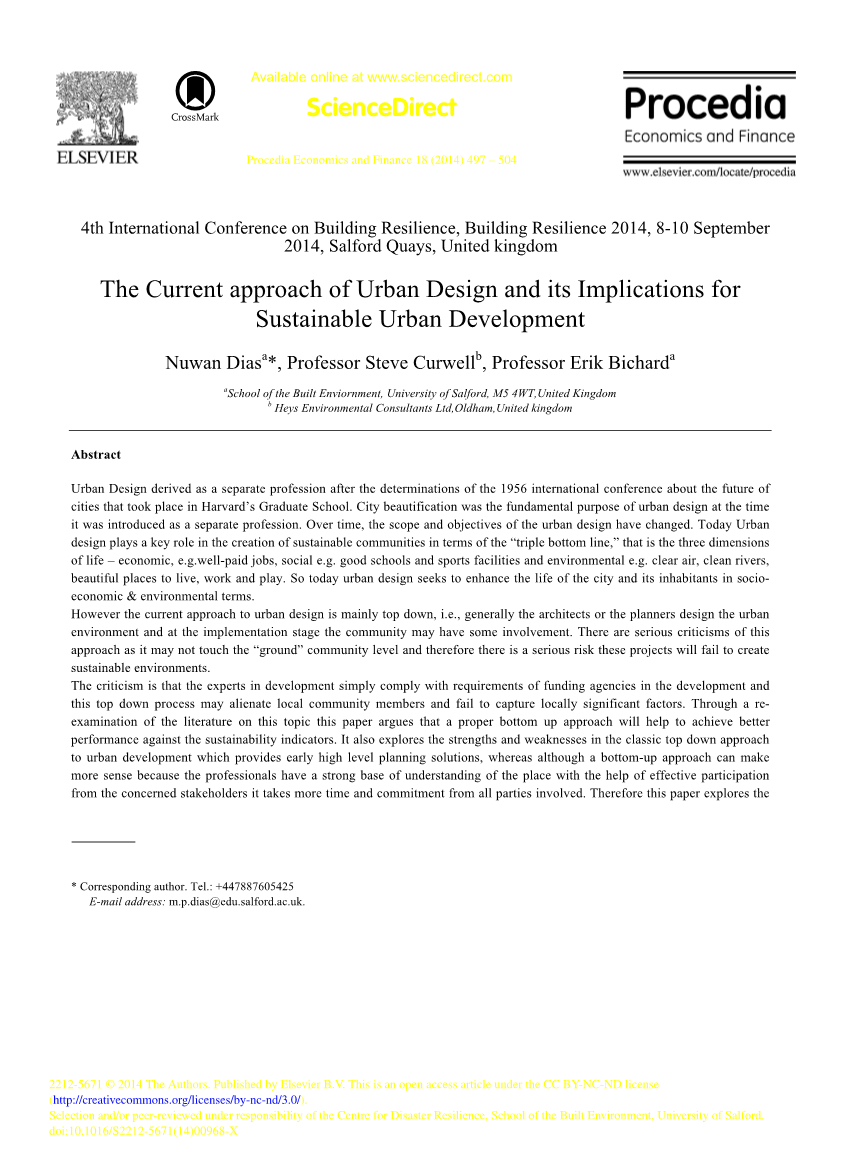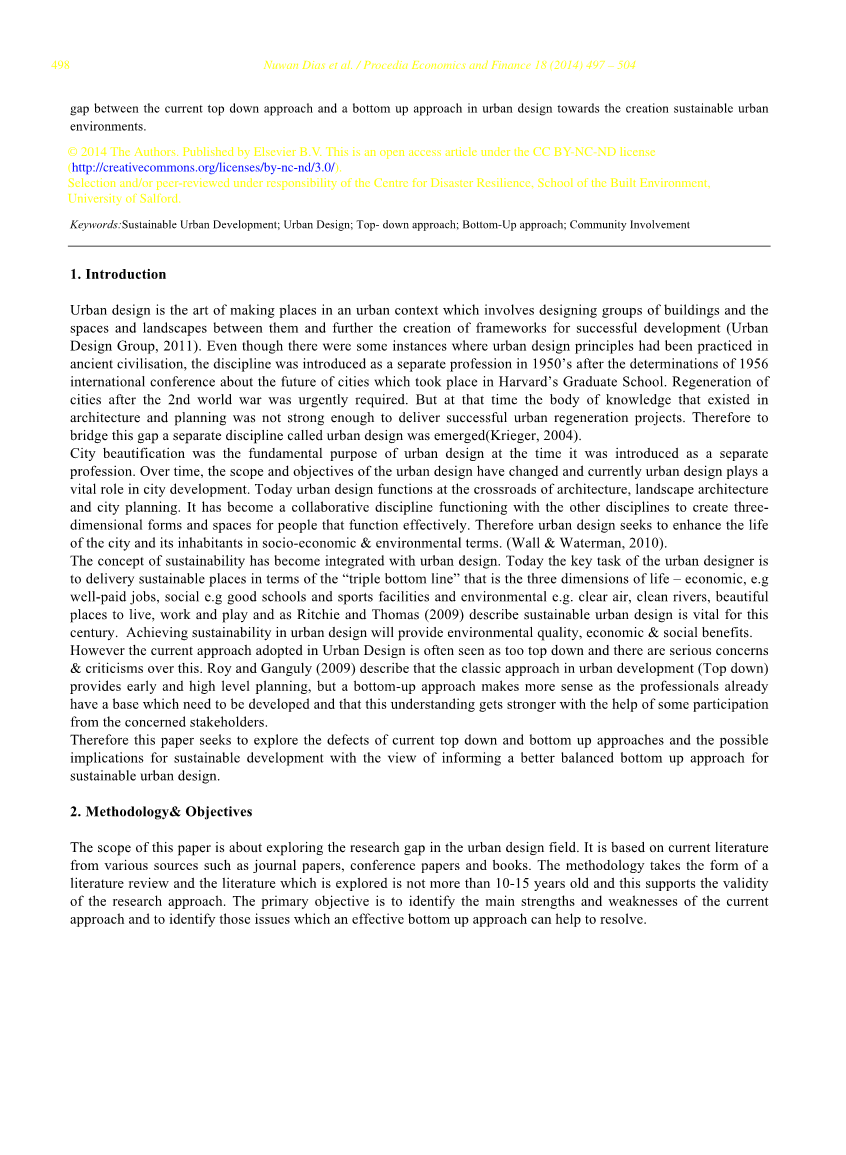The Current approach of Urban Design and its Implications for Sustainable Urban Development
当前城市设计方法及其对城市可持续发展的启示
Abstract
摘要
Urban Design derived as a separate profession after the determinations of the 1956 international conference about the future of cities that took place in Harvardrsquo;s Graduate School. City beautification was the fundamental purpose of urban design at the time .it was introduced as a separate profession. Over time, the scope and objectives of the urban design have changed. Today Urban design plays a key role in the creation of sustainable communities in terms of the “triple bottom line,” that is the three dimensions of life – economic, e.g.well-paid jobs, social e.g. good schools and sports facilities and environmental e.g. clear air, clean rivers, beautiful places to live, work and play. So today urban design seeks to enhance the life of the city and its inhabitants in socio-economic amp; environmental terms.
在1956,国际会议通过了在哈佛的研究生院发表的《城市的未来》之后, 城市设计成为了一个独立的职业。城市美化是当时城市设计的根本目的. 城市设计被介绍作为一个单独职业。随着时间的推移, 城市设计的范围和目标也发生了变化。今天, 城市设计在建立可持续社区方面起着关键作用, 即 '三重底线', 即生活的三维度--经济:例如高薪工作;社会:例如好学校、体育设施和环境: 如空气清澈、干净的河流, 美丽的地方生活, 工作和玩耍。因此, 今天的城市设计力求在社会经济和环境条件下提高城市及其居民的生活。
However the current approach to urban design is mainly top down, i.e., generally the architects or the planners design the urban environment and at the implementation stage the community may have some involvement. There are serious criticisms of this
approach as it may not touch the “ground” community level and therefore there is a serious risk these projects will fail to create sustainable environments.
然而目前的城市设计方法主要是自上而下的, 即一般建筑师或规划者设计城市环境, 在实施阶段,社区可能会有一些参与。对这种做法应该要严重的批评, 因为它可能不会触及 '地面' 社区的水平, 因此, 这些项目将无法创造可持续的环境, 这是一个严重的风险。
The criticism is that the experts in development simply comply with requirements of funding agencies in the development and this top down process may alienate local community members and fail to capture locally significant factors. Through a re-examination of the literature on this topic this paper argues that a proper bottom up approach will help to achieve better performance against the sustainability indicators. It also explores the strengths and weaknesses in the classic top down approach to urban development which provides early high level planning solutions, whereas although a bottom-up approach can make more sense because the professionals have a strong base of understanding of the place with the help of effective participation from the concerned stakeholders it takes more time and commitment from all parties involved. Therefore this paper explores the gap between the current top down approach and a bottom up approach in urban design towards the creation sustainable urban
environments.
值得批判的是, 发展方面的专家只满足资助机构在发展方面的要求, 而这项自上而下的过程可能会疏远本地社区成员, 未能捕捉本地的重要因素。本文通过对有关这一主题的文献的重新审视, 提出了一个适当的自下而上的方法, 将有助于在可持续发展指标方面取得更好的表现。它还探讨了传统的自上而下的城市发展方法的优缺点, 提供早期高层次规划解决方案。 自下而上的方法可以更有意义, 因为专业人士有一个强大的基础,在相关利益相关者有效参与的帮助下了解这个地方, 需要更多的时间和承诺。因此, 本文探讨了当前自上而下的方法与城市设计中的自下而上方法之间的差距, 以创造可持续的城市环境。
- Introduction
1.介绍
Urban design is the art of making places in an urban context which involves designing groups of buildings and the spaces and landscapes between them and further the creation of frameworks for successful development (Urban Design Group, 2011). Even though there were some instances where urban design principles had been practiced in ancient civilisation, the discipline was introduced as a separate profession in 1950rsquo;s after the determinations of 1956
international conference about the future of cities which took place in Harvardrsquo;s Graduate School. Regeneration of cities after the 2nd world war was urgently required. But at that time the body of knowledge that existed in architecture and planning was not strong enough to deliver successful urban regeneration projects. Therefore to bridge this gap a separate discipline called urban design was emerged(Krieger, 2004).
城市设计是在城市环境中创造空间的艺术, 它涉及设计建筑物群和它们之间的空间和景观, 并进一步创造成功发展的框架 (城市设计小组, 2011)。尽管在某些情况下, 城市设计原则已经在古代文明中实行, 但在1956年关于城市未来的国际会议确定之后, 这门学科才在1950年被引入为一个独立的职业。在第二次世界大战之后重建城市是迫切需要的。但当时, 建筑和规划中存在的知识体系不够强大, 无法提供成功的城市再生项目。因此, 要弥合这一差距, 就出现了一个叫做城市设计的独立学科 (克里格, 2004)。
City beautification was the fundamental purpose of urban design at the time it was introduced as a separate profession. Over time, the scope and objectives of the urban design have changed and currently urban design plays a vital role in city development. Today urban design functions at the crossroads of architecture, landscape architecture and city planning. It has become a collaborative discipline functioning with the other disciplines to create three-dimensional forms and spaces for people that function effectively. Therefore urban design seeks to enhance the life of the city and its inhabitants in socio-economic amp; environmental terms. (Wall amp; Waterman, 2010).
当城市设计被引入作为一个独立的职业,城市美化是城市设计的根本目的。随着时间的推移, 城市设计的范围和目标发生了变化, 目前城市设计在城市发展中起着举足轻重的作用。今天, 城市设计在建筑、景观建筑和城市规划的十字路口上发挥着作用。它已成为一个协作的学科, 与其他学科, 创造三维形式和空间的人, 协同有效地运作。因此, 城市设计力求在社会经济和环境条件下提高城市及其居民的生活。(墙壁和船夫, 2010)。
The concept of sustainability has become integrated with urban design. Today the key task of the urban designer is to delivery sustainable places in terms of the “triple bottom line” that is the three dimensions of life – economic, e.g well-paid jobs, social e.g good schools and sports facilities and environmental e.g. clear air, clean rivers, beautiful places to live, work and play and as Ritchie and Thomas (2009) describe sustainable urban design is vital for this century. Achieving sustainability in urban design will provide environmental quality, economic amp; social benefits.
可持续性的概念已与城市设计融为一体。今天, 城市设计师的主要任务是以 '三重底线' 的方式创造可持续的地方, 这是生活的三个维度-经济:高薪工作;社会:良好的学校和体育设施和环境:如清新空气, 清洁河流, 美丽的地方生活, 工作和玩耍, 作为里奇和托马斯 (2009) 描述的可持续的城市设计的关键。在城市设计中实现可持续性将提供环境质量、经济和社会效益。
全文共32911字,剩余内容已隐藏,支付完成后下载完整资料


英语原文共 8 页,剩余内容已隐藏,支付完成后下载完整资料
资料编号:[12028],资料为PDF文档或Word文档,PDF文档可免费转换为Word
以上是毕业论文外文翻译,课题毕业论文、任务书、文献综述、开题报告、程序设计、图纸设计等资料可联系客服协助查找。


